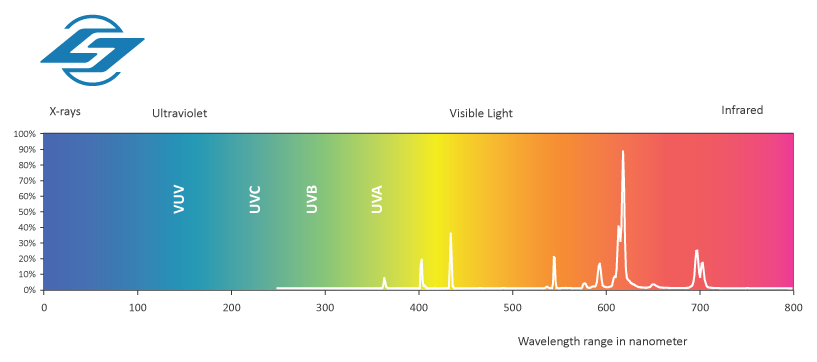The Main Principles Of Uvc Light
The Main Principles Of Uvc Light
Blog Article
Not known Facts About Uvc Light
Table of ContentsUvc Light - TruthsSome Ideas on Uvc Light You Need To Know6 Easy Facts About Uvc Light ExplainedThe smart Trick of Uvc Light That Nobody is Talking AboutThe Single Strategy To Use For Uvc LightAll About Uvc Light
A brand-new sort of ultraviolet light that might be secure for individuals took much less than 5 minutes to lower the level of indoor airborne microorganisms by greater than 98%, a joint study by scientists at Columbia University Vagelos University of Physicians and Surgeons and in the U.K. has discovered. Also as germs continued to be sprayed right into the area, the degree remained extremely reduced as lengthy as the lights got on.Yet previously these studies had only been carried out in little speculative chambers, not in full-sized areas imitating real-world problems. In the present research study, researchers at the College of St. Andrews, University of Dundee, College of Leeds, and Columbia College tested the efficacy of far-UVC light in a big room-sized chamber with the same air flow price as a regular office or home (regarding three air changes per hour).
The efficacy of different methods to reducing interior virus degrees is usually determined in regards to comparable air changes per hour. In this research study, far-UVC lamps generated the equivalent of 184 comparable air exchanges per hour. This surpasses any type of various other strategy to disinfecting occupied interior areas, where five to 20 comparable air adjustments per hour is the very best that can be attained virtually.
4 Simple Techniques For Uvc Light

The major parameters of UV-C sanitation are wavelength, dose, loved one humidity, and temperature level. There is no agreement about their ideal worths, but, generally, light at a high dose and a range of wavelengths consisting of 260 nm is preferred in an atmosphere at space temperature with reduced loved one moisture. This light can be created by mercury-vapour, light-emitting diode (LED), pulsed-xenon, or excimer lamps.
UV-C sanitation systems have appealing features and the prospective to boost in the future. UV-C sanitation should currently be considered for low-level rather than high-level disinfection.
An additional application arose in 1910 when UV light was made use of to decontaminate water. The technology was not extremely reputable at the time and it took additionally technological developments prior to UV water disinfection became preferred once again in the 1950s [ 2] Nowadays, UV light is made use of for water, air, food, surface area, and clinical tools sanitation.
Uvc Light Fundamentals Explained
This results in the disruption of DNA or RNA, leading to the inactivation of the micro-organism. UV-C-induced DNA disruption often consists of the bonding of 2 adjoining thymine (or cytosine) bases instead of the conventional linking of a base uvc light with its complementary base on the various other hair.

Dark repair, on the other hand, calls for multiple enzymes and nutrients for energy [6] It is very important to understand whether last inactivation results have considered the occurrence of resurgence since it may cause 60% of the attained inactivation being reversed [7] Mutations can emerge upon UV-C exposure since this exposure can result in the source of intra-strand cyclobutyl-pyrimidine dimers in DNA [ 6] The UV-C area is utilized for disinfection however there is no agreement on the exact ideal wavelength. Microbial DNA and RNA have peak absorbances of light at 260265 nm and around 260 nm, respectively [6] Light at 260 nm can trigger the most disruption (uvc light). Nevertheless, numerous micro-organisms are most prone to somewhat various wavelengths.
About Uvc Light
It also has an extra benefit by reducing photoreactivation via a reduction of photolyase [9] On the various other hand, it has technological implications since the overall power of the light beam of light is then separated over all present wavelengths. For that reason, a micro-organism that is vulnerable to 254 nm light will be suspended extra by a lamp that sends out only light at 254 nm than a lamp that gives off a wavelength range at equal total energy.
Direct exposure times of 1045 min for room disinfection and 25 s to 5 minutes for clinical tools were come across in literary works.
Even more, the result of a lamp decreases over time, so it is recommended to determine the dose at the view end of light life, which is rep of a worst-case circumstance. The dose likewise influences the quantity of photoreactivation.
The influence of temperature level depends on the light source.
The Best Guide To Uvc Light


This is referred to as much UV-C modern technology and is a fairly new sanitation approach with restricted expertise concerning its performance. This makes it riskier to entirely depend on this technology for sanitation in the healthcare facility and it is for that reason not extensively utilized [21] Nevertheless, it likewise has advantages such as a decreased threat for usage near individuals because of a reduced infiltration depth into the skin and eyes [ 26]
In research study, the outcomes on pulsed versus continuous UV-C sanitation effectiveness differ. When contrasting pulsed and constant light it is essential to maintain various other variables such as wavelength and dose constant. Nyangaresi content et al. and Sholtes et al. both located that pulsed or continual light sent out by LEDs caused equivalent log10 reductions [15,28]
The Only Guide for Uvc Light
In instance ozone is not required for sanitation, a modified lamp can be utilized. For mercury-vapour lamps, doped quartz glass or specialized soft glass can filter out short-wave UV-C light - uvc light.
Report this page